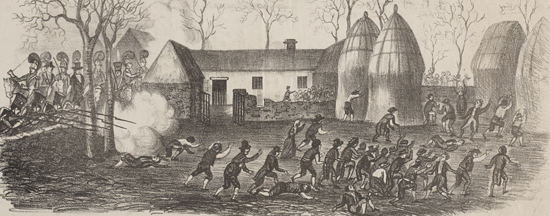Tithe Applotment Books
Published in Features, Issue 4 (July/August 2019), Volume 27By Fiona Fitzsimons
This year marks the 150th anniversary of the Irish Church Act (1869), which disestablished the Church of Ireland. As the State church, the Church of Ireland was an arm of the government at local level. Its basic administrative unit was the civil parish. All the people of the State were required to support the established church with tithes, paid in kind (agricultural produce or services) or in cash.
In 1823 an Act of Parliament converted tithes to a cash payment charged on land, to be applied uniformly to both pasture and tillage. Payment was calculated using the average price of wheat and oats sold in the parish in the seven years before 1 November 1821. The measure by which the tithe rate was calculated and the timing of its introduction were badly judged, as agricultural prices had collapsed at the end of the Napoleonic Wars. Each parish had two tithe commissioners, one elected by the rate-payers, the other nominated by the diocese. Between 1823 and 1837 the commissioners carried out a national survey at parish level and used it to set the tithe. They set down the evidence in Tithe Applotment Books (TABs) and certified it as an accurate record. Almost all the books include correspondence and some have maps. There is a subset in the collection that survives not as books but as handwritten responses on printed questionnaires.
The information recorded is fairly uniform and includes the townland name, names of tenants, the size of the holding (acres, roods and perches), its valuation and the tithe paid. As with all manuscripts, diligent researchers will find many occasions when the commissioners digressed from the job at hand and recorded other evidence, some of which can be very useful to family and social historians.
In 1825 the tithe commissioner for the parish of Aghnameadle, Co. Tipperary, included the names of all chief tenants, as well as the tenant on the land. In April 1829 the tithe commissioners for the united parishes of Castlekyran, Loughan and Lurgan (counties Meath and Cavan) occasionally recorded the names of previous tenants. In the townland of Ardaman, Laurence Fannan occupies lot 4, ‘formerly [held by] James Darby’, while at lot 9 George and Henry Power occupied a smallholding described as ‘formerly Thomas Brady’.
The collection comprises more than 2,500 manuscript volumes, describing every rural parish in Ireland. They don’t, unfortunately, record the urban parishes. The corresponding urban records that were made—Ministers’ Money—have not survived.

Above: ‘The Massacre at Gortroe’ (near Rathcormac, Co. Cork), where twenty protesting locals were killed on 18 December 1834 in one of the many ‘battles’ of the Tithe War. (NLI)
In the 1830s a popular movement united in opposition to paying tithes in what became known as the Tithe Wars. Legislation in 1833 and 1838 transferred payment of tithes from tenants to landlords. The TABs were transferred to the Corporation of the Commissioners of Church Temporalities in Ireland, and after 1881 to the Land Commission. After 1940, the Land Commission deposited the TABs in the Public Records Office. Records of the TABs for the island of Ireland are available on Ancestry. Records for the Republic are published online by the National Archives and Familysearch.org. If you still prefer to research the analogue way, records for Northern Ireland are on microfilm in PRONI and can be viewed by visitors.
Fiona Fitzsimons is a director of Eneclann, a Trinity campus company, and of findmypast Ireland.
















